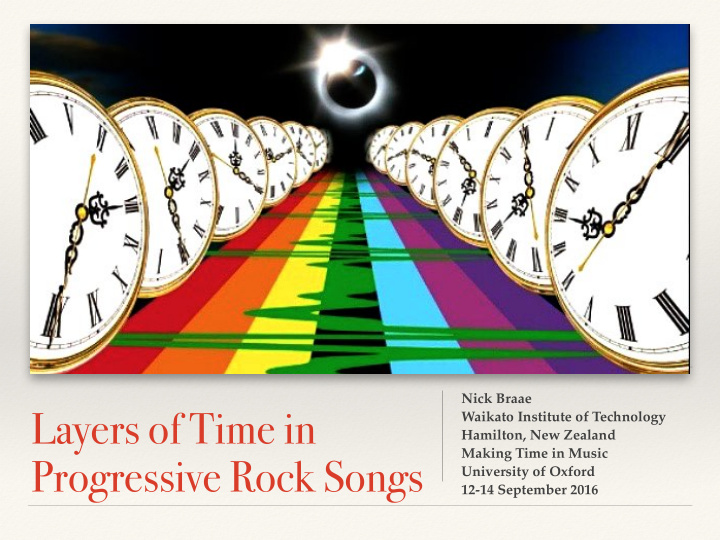



Nick Braae Layers of Time in Waikato Institute of Technology Hamilton, New Zealand Making Time in Music Progressive Rock Songs University of Oxford 12-14 September 2016
Progressive Rock Analysis: Structure and Time ❖ Sonata form in Yes’ “Close to the Edge” (Covach 1997); motivic development in Yes’ “Awaken” (Palmer 2001); tableaux in Genesis’ “Supper’s Ready” (Spicer 2008) ❖ “The possibility of a move for popular song from the self- contained, three-minute love song, produced for purposes of entertainment alone, into new means of expression” (Moore 2012, p. 144) ❖ Progressive rock and the evocation of distinct metaphorical journeys through time: static, disruptive, linear
The Concept of Musical Time ❖ Musical time: the experiential pace, trajectory and flow of music ❖ “All music creates an order of virtual time, in which its sonorous forms move in relation to each other” (Langer 1953, p. 109-10) ❖ “Music is one of the forms of duration; it suspends ordinary time, and offers itself as an ideal substitute and equivalent” (de Sélincourt 1920) ❖ David Randolph (unattributed): Wagner’s Parsifal is “that kind of opera that starts at six o’clock and after it has been going three hours you look at your watch and it says 6.20” ❖ Kramer’s The Time of Music (1988): different forms of temporality in classical music, according to musical characteristics and cultural context of listener; also Adlington 2001; Pasler 1982; Agawu 1988; Hyland 2009
Different Modes of Temporality ❖ Linear/directional: commonly associated with harmonic-structural design of sonata form ❖ Non-linear/non-processual: associated with the fragmentary nature of 20th-C classical music ❖ Multiply-directed time: music progresses towards multiple goals concurrently (Holm-Hudson 2002; on King Crimson)
Static Surfaces in Progressive Rock ❖ “Vertical” time: musical stasis; often manifest in local harmonic structures ❖ Pink Floyd’s “Shine on You Crazy Diamond” (introduction): static G minor or slow harmonic rhythm ❖ Pink Floyd’s “The Great Gig in the Sky”: constant harmonic loop ❖ Yes’ “Close to the Edge” (“bridge” section): washed background texture; declamatory melody; reverberant space; lack of bass frequencies
Large-Scale Directionality ❖ Temporal disjunctures in the middle ground (sharp contrasts and sudden transitions between sections; perhaps in more “experimental” prog rock, e.g. Gentle Giant, King Crimson) ❖ Linearity associated with the recapitulation of initial material (in the original key) ❖ Jethro Tull’s “Aqualung”: triumphant restatement of chorus ❖ Queen’s “The Prophet’s Song” and “Millionaire Waltz”: return of initial material with richer textures ❖ Queen’s “Liar”: no return of thematic material but rhetoric of an arrival ❖ Yes’ “Awaken”: lengthy build-up; climactic moment instrumental
Concurrent Temporal Layers ❖ Pink Floyd’s “Eclipse” (conclusion of Dark Side of the Moon ) ❖ Fragmented form across the album (jumping from song to song) ❖ Stasis at the phrase level (chord loop; limited vocal shape) ❖ Linear gestures through grandiose texture to close album
Time and Progressive Rock Influences and Aesthetics ❖ Progressive rock and the counterculture: “[it] found its strongest following among….the hippie counterculture during the late 1960s/early 1970s that opposed both elite and mainstream popular culture” (Keister and Smith 2008, 446); conflicting relationship, for instance, between counterculture and “elitism” of classical music (see Lundberg 2014). ❖ Stasis from psychedelic style: “the hippies insisted on the importance of subjective experience and of the ‘now’” (Willis qtd. in Moore 2001, p. 99) ❖ Linearity from the high-art influence of 19th-century classical music ❖ Fragmented form from the avant-garde impulse of the 1960s ❖ Fusion of temporal procedures representing the attempt to create a new popular art form
Recommend
More recommend